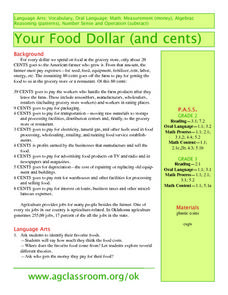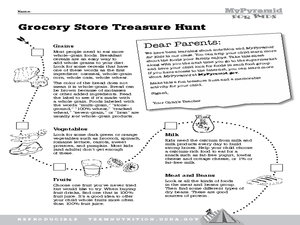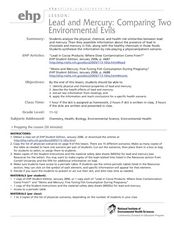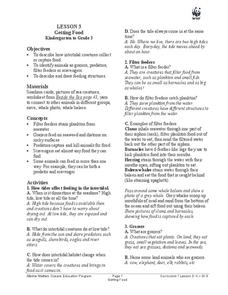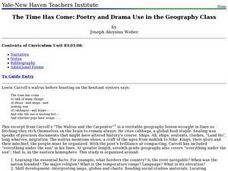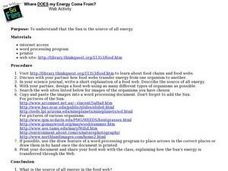Curated OER
Where Did My Lunch Come From? A U.S. Regional Tour
Young scholars explore the five regions of the United States. In this social studies lesson, students discuss the regions and the states located in that region. Young scholars discuss the types of food produced in each region and analyze...
Curated OER
World Food
After reading a short paragraph about popular world foods, language learners complete a word search and answer eight questions based on the paragraph. No answer key is provided.
Curated OER
Where Does It Come From?
Students research agricultural commodities. In this agricultural commodities lesson, students read background information about food products and commodities. Students complete worksheets with specific product information including its...
NOAA
Animals of the Fire Ice
When the sun's rays can't reach the producers in a food web, where does all the energy come from? Extreme environments call for extreme food sources. Young scientists investigate creatures that appear to get their energy from methane...
Curated OER
Where in the World?
Students evaluate botany by participating in a class discussion. In this agriculture lesson, students identify the importance of knowing where food comes from and they discuss what their breakfast consisted of and where it came from....
Curated OER
Your Food Dollar (and Cents)
Students examine where their food dollars go while recognizing coins and making change. They identify their favorite foods, receive one dollar, and take away amounts for each person involved in the production of their food dollar.
Curated OER
Breaking the Food Chain
Students investigate the food chain. They brainstorm questions about the human food chain and explain what would happen to living things in the food chain if organisms or resources were removed. They role-play situations in which the...
University of California
Energy and Biomass Pyramids
Young scientists play tag as they act out the food pyramid in the ocean ecosystem. Energy circles pass from the smaller prey to the predators and at the end of the activity, a data chart and analysis questions allow pupils to apply their...
National Geographic
Spot Where You DON'T Get Your Seafood
When your class is examining the fishing industry or sustainable practices, you can use this brief activity to demonstrate the global impact our food choices have. Overharvesting, overfishing, and bycatch are important topics to address...
Curated OER
Bake, Boil, or Fry
Students write a journal entry about where there food comes from. In this Civil War activity, students discuss journals, the crops grown within the U.S., the import/export process and what food preparation must have been like on a...
Curated OER
Eat Smart with MyPyramid for Kids
Students investigate food examples from the food groups to explore a healthy diet. In this healthy eating lesson, students study the food pyramid and complete related worksheets. Students also play pyramid go fish.
Curated OER
Classification and Adaptations- Streams, Rivers, and Lakes - Where the Land Meets the Sea And Caribbean Reef
In this science worksheet set, students answer 14 short answer questions about the classification and adaptation of life in streams, rivers, and lakes. They also answer 15 questions about life "Where the Land Meets the Sea" and in a...
Curated OER
Energy Balance in Your Life
How do young learners figure out how to balance their energy in and their energy out? The main thing to understand is calories. How many calories are in foods and beverages consumed and how many calories are burned off by physical...
BBC
Global Community: T-Shirt Activity
Examine fair trade and the impacts it has on the global community. Kids consider how t-shirts are made, where they come from, and how fair trade works. They design t-shirts that describe the affects of fair trade on various populations...
Chymist
Determination of the Volume of CO2 in Pop Rocks
Where does the pop in pop rocks come from? An engaging activity asks scholars to measure the amount of carbon dioxide in a package of Pop Rocks candy. Learners dissolve the candy in water and use the solubility of CO2 to determine its mass.
Serendip
How Do Muscles Get the Energy They Need for Athletic Activity?
Every muscle movement requires energy, but where does that energy come from? Scholars answer this question and more as they complete a worksheet. By following the directions, completing research, and discussing it as a class, they begin...
Curated OER
Lead and Mercury: Comparing Two Environmental Evils
High schoolers in chemistry or health courses look at the material safety data sheet (MSDS) and periodic table of elements to gather information about mercury and lead, two toxic materials that have been found in food products. They read...
Curated OER
Vital Work
Students consider the role of women in the food industry. For this gender exploitation lesson, students work in groups to examine unfair labor practices. Students watch a video and write a fictional letter from a female laborer. This...
Curated OER
Horseshoe Crab Fun
Marine biology masters will meet the horseshoe crab and red knot shore birds that feast upon the crab eggs. Begin with a discussion and then have learners write postcards from each animal detailing their migration trips. A few math...
Science & Plants for Schools
Photosynthesis - A Survival Guide
Young scientists learn what it takes for life on Earth to survive with this series of photosynthesis resources. Offering twelve different activities ranging from independent practice worksheets to in depth scientific...
Curriculum Corner
My Book of Poems
Copy all pages to create a book of poems during a poetry study. From alliteration to cinquain to acrostic poem, your class won't run out of templates for writing poems! Each sheet serves as a template for an entire book of poems. Other...
Curated OER
Getting Food
Students complete activities to learn about the ocean food web. In this ocean life lesson plan, students discuss how the tides affect feeding, learn about filter feeders, grazers, predators, and scavengers. Students then group the...
Curated OER
The Time Has Come: Poetry and Drama Use in the Geography Class
Students use drama and poetry in their Geography class. In groups, they role play an interviewer or the interviewee in various plays that were presented to them. In their role, they must locate and label where the countries mentioned...
Curated OER
Where Does My Energy Come From?
Students gain an understanding that the Sun is the source of all energy. With a partner, they examine various web sites to explore food chains and food webs, later sharing their findings with the class.







